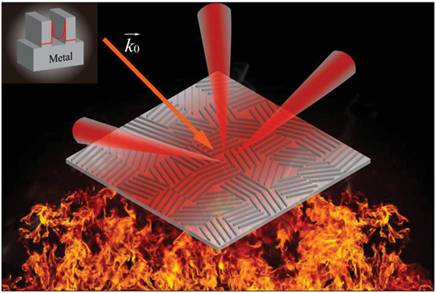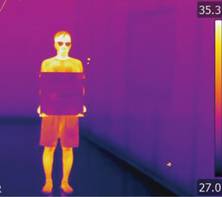Metallic Metasurface: How to Stay Under the Radar?
In stealth technology however the strong reflection of electromagnetic waves by metal is disadvantageous in order to remain undetected. Though radar scattering signal could be reduced by changing the geometries of objects to guide the reflected wave into other directions, shaping the physical geometry is usually undesired due to other physical constraints, such as the compatibility of aero- and hydrodynamics.

Schematic of the heat resisting metallic metasurface, showing the electromagnetic scattering in the upper half‐space. Inset illustrates two adjacent elements and the located catenary optical field.
As a type of two-dimensional metamaterials, metasurface has been a topic of considerable interest in recent years. According to generalized Snell’s law, the reflection and transmission electromagnetic wavefronts can be reshaped by the local phase control of the metasurfaces. Recently, various building blocks based on metal-insulator-metal (MIM) structures have been presented. This approach uses the random distribution of local reflection phases of unit cells, which enables diffuse electromagnetic scattering. Consequently, the radar cross section (RCS) would be dramatically reduced.
A team of researchers from the State Key Laboratory of Optical Technologies on Nano-Fabrication and Micro-Engineering, from the Chinese Academy of Sciences designed an all-metallic metasurface, using high-temperature resistant metal materials.

Infrared emission characterization for the metasurface at room temperature.
By optimizing the catenary optical fields and dispersion, broadband and wide-angle diffusion in the microwave band was realized. Unlike previous diffusers, the echo reflection is subtly suppressed, thus minimizing the target RCS. In addition, the structure is compatible with both high temperature and infrared camouflage performance. The authors believe that this approach is expected to provide a surface coating for electromagnetic feature control. ( advanced science news)
Contact
CAO Qiang
Institute of Optics and Electronics
Email: caoqiang@ioe.ac.cn
